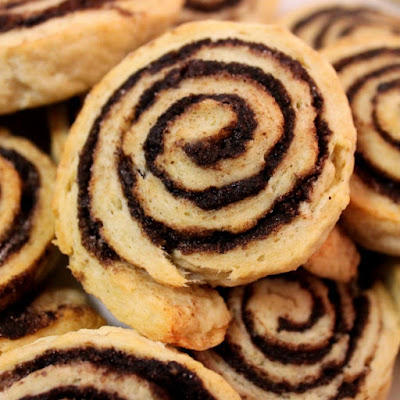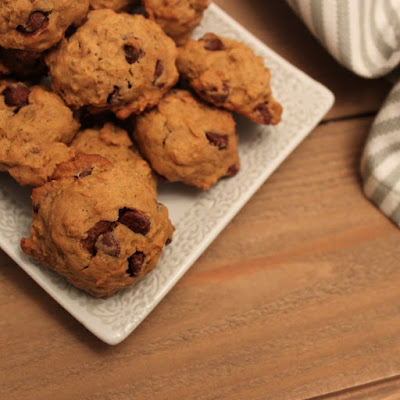After creating these cupcakes, I realized the importance of finishing touches on a baked good. These special touches can be just to enhance appearance of items, like using sprinkles. However, in addition to the visual enhancement, a finishing touch should also add more flavor to the dessert.
These cupcakes have walnuts on top of the icing. You may think it is no big deal, but let me clue you in further. The walnuts are chopped and roasted in the oven. Then, while still warm, they are coated in melted butter with a light sprinkling of salt. This creates a wonderful contrast to the fluffy, sweet cream cheese icing. I would not even think of omitting the nuts on top.
Now that I have your taste buds awake concerning the icing and nut topping, let's get into the cake component. The cake contains oil instead of butter, which guarantees they will be moist in texture. Also, the myriad of spices in the batter with the grated carrots equates to the delicious standard that we all crave when it comes to carrot cake. This recipe makes about 2 dozen cupcakes and about 4 cups or more of icing (feel free to cut back on this).
Carrot Cupcakes
adapted from Robicelli's
Ingredients/Cake
1 1/4 cups canola or grapeseed oil
1 tsp vanilla extract
4 eggs, lightly beaten
1/2 tsp ginger
1/2 tsp nutmeg
3/4 tsp cinnamon
1 tsp salt
1 tsp baking powder
1 tsp baking soda
2 1/4 cups flour
1 cup granulated sugar
1 cup packed light brown sugar
2 cups packed shredded/grated carrots
1/2 cup chopped, roasted walnuts
1/2 cup raisins (optional)
Ingredients/Cream Cheese Buttercream
1 batch French buttercream (recipe below) or 1 batch American buttercream but without marscapone cheese ingredient (see this link)
1 tsp vanilla extract
8 oz package cream cheese (cut into cubes)
1/4 tsp guar gum (optional)
Ingredients/French Buttercream
5 egg yolks
1 whole egg
1 lb to 1 1/2 lbs of butter
1 cup water
2 tbs corn syrup
1/8 tsp xanthan gum
Ingredients/Roasted Walnuts
1 1/2 tsp salt
1 cup coarsely chopped walnuts
1 tbs butter
Start by setting up a stand mixer with a paddle attachment. Grease the top edge of each cavity of a cupcake pan. There should be 2 pans prepared with 12 cavities each. Line the cavities with paper liners. Preheat the oven to 350 degrees.
Place a sieve over a large bowl. Fill with flour, nutmeg, salt, cinnamon, ginger, baking soda and baking powder. Sift the ingredients together and set aside.
Fill the bowl of the stand mixer with both sugars and the grated/shredded carrots. Mix on medium low for about 30 seconds and scrape down the sides of the bowl. Then mix for an additional 30 seconds. Continue to run the mixer on the same speed and pour in the vanilla extract and oil. Once combined, remove the bowl from the stand and use a spatula and scrape down the sides and mix, making sure all is blended.
Add the sifted ingredients to the sugar/carrot batter and mix, using a wooden spoon until everything is fully incorporated. Add the eggs and mix again until blended. Lastly, fold in the walnuts and raisins (if using).
Using a scoop, fill each of the paper lined cavities with the batter. They should only be 3/4 of the way full. Place each pan in the oven (on the same or different racks-making sure they are spaced so each pan is to the left or right so they get enough heat). Bake for 10 minutes and then rotate the pans from front to back and left to right. Let bake an additional 10 minutes and check with a tester. When done, the tester will be clean and cupcakes should spring back when lightly touched.
Remove from oven and let rest in pans about 2-3 minutes. Keep the oven on. Then transfer to a rack to completely cool.
To roast the walnuts, line a pan with foil and add the 1 cup of chopped nuts. Spread out evenly onto the pan and place in oven. Roast for about 7-10 minutes. Walnuts will release an aroma once done. Once roasted, make a foil pouch with the foil that you lined the pan with, enclosing all of the nuts. Open up a small hole on top and add the salt. Close up and shake. Open the top again and pour in the melted butter. Close and shake again then set aside.
If you are making the French buttercream, place a saucepan on the stove. Fill with the water, corn syrup, sugar and cream of tartar- you do not need to mix together. Turn the heat up to high and let cook. Once it becomes a liquid, place a candy thermometer in the pan. The mixture will cook up to a boil, but do not stir. It will be ready to use once it reaches a temperature of 235 degrees.
As the liquid cooks, fill the bowl of a stand mixer (fitted with a whisk attachment) with the egg and egg yolks. Turn the mixer to high. This process will change the eggs to a light yellow batter that falls of the whisk in silky ribbons.
While the sugar is cooking and the eggs are being beaten, slice the butter into thin slivers. Take a few moments to still monitor the sugar mixture for correct temperature. Once the sugar reaches the desired temperature, remove the saucepan from the stove. Turn the mixer to medium speed and sprinkle the xanthan gum into the silky egg mixture. Continue to run the mixer and lift the hot saucepan and place the lip or top edge against the edge of the bowl of the stand mixer. Slowly stream in the hot sugar mixture. Keep a steady stream going until the saucepan is completely empty.
Switch the speed of the mixer to high and beat until the outside of mixing bowl is cool to the touch. Once correct temperature is achieved, turn the mixer off and take off whisk and fit with beater blade. Switch on the mixer again and set at high speed. Steadily add butter slices to the batter as the mixer is running. After all the butter is blended, reduce speed to medium high and beat for an additional 20 seconds.
Now you will use this batch (or the American Buttercream) to create the cream cheese frosting. Add the vanilla extract and the cubes of cream cheese to the buttercream. Beat until cream cheese is fully incorporated into batter. Pipe frosting onto batter and sprinkle with walnut pieces.
Tips and notes:
1. Buttercream requires refrigeration and cupcakes are best not refrigerated, so I frosted the cupcakes right before serving.
2. If you have chosen the French buttercream, be aware that it is the most unstable of the 2 types of frosting. This is why the recipe contains stabilizers such as guar gum and xanthan gum.
3. The amount of butter in the French buttercream frosting is a personal preference. I only used 1 lb and it still came out delicious with the correct consistency.
4. When making the French buttercream, there is a risk of the buttercream breaking when mixing with the cream cheese. In order to prevent this, make sure your cream cheese is ice cold and solid-not liquidy. Guar gum is the remedy if it breaks, but it is used in such a small quantity, some of us do not keep it on hand.
5. The xanthan gum is also a binding agent, it is more important than the guar gum. It helps bind eggs with water- which is essential to a good buttercream.
6. If the butter is all sliced before the egg mixture has cooled, refrigerate until ready to use.
7. If you want to buy shredded carrots instead of doing the shredding, be aware that the shredded carrots at the grocer have lost a lot of moisture. You can remedy this by soaking them overnight in a bowl of water. Drain before using.
**LAST YEAR:Almond Frangipane Cookies**




